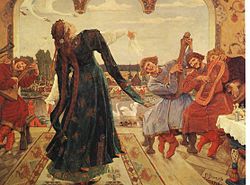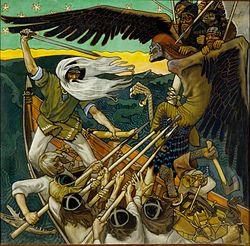Shapeshifting

Shapeshifting is the act of being able to change into another being or form.[1][2] The idea of shapeshifting has been around since the Middle Ages. It has been used in literature and epic poems, including works such as Peleus and Thetis[3] and the Iliad. The trend of shapeshifting is still being done today. It is a theme in children's literature, and works of popular culture.
Shapeshifting Media
Vertumnus, in the form of an old woman, wooing Pomona, by Gerbrand van den Eeckhout.
Kelpie by Herbert James Draper: transformed into a human
The Children of Lir, transformed into swans in Irish tales
"The giant Galligantua and the wicked old magician transform the duke's daughter into a white hind." by Arthur Rackham
Loge feigns fear as Alberich turns into a giant snake. Wotan stands in the background; illustration by Arthur Rackham to Richard Wagner's Das Rheingold
Louhi, Mistress of the North, attacking Väinämöinen in the form of a giant eagle with her troops on her back as she tries to steal Sampo; in the Finnish epic poetry Kalevala by Elias Lönnrot. (The Defense of the Sampo, Akseli Gallen-Kallela, 1896)
References
- ↑ Treatise on Invisible Beings
- ↑ Creatures of the Night
- ↑ "Peleus and Thetis". Archived from the original on 2015-01-16. Retrieved 2014-12-16.
Other websites
- The Evolution of the Vampire in Fiction and Popular Culture Archived 2015-05-01 at the Wayback Machine
- Real Shapeshifters Website Archived 2019-10-13 at the Wayback Machine Dedicated to the study of shapeshifting phenomena (realshapeshifters.com)
- Shapeshifters in Love Archived 2007-05-12 at Archive.today – A series of articles about shapeshifting characters in romance and speculative fiction.





